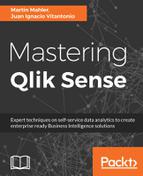This chapter in Mastering Qlik Sense gave the reader a comprehensive understanding of the breadth of available Qlik Sense APIs, which can be utilized to build compelling extensions, widgets, mashups, and web apps. In particular, the four core Qlik APIs have been described, which are the Engine API, Extension API, Backend API, and Capability API, which includes 10 subcategories of APIs.
With those, the reader should be able to leverage the associative Qlik data engine and implement almost any functionality that is also possible in Qlik Sense, but in a different context for a custom implementation. While not difficult per se, utilizing the API still requires a basic understanding of HTML, JavaScript, AngularJS, and WebSockets, which are described in Chapter 12, Coding in Qlik Sense. This, however, should not be discouraging for Qlik developers who do not have a JavaScript background. It's equally important to be able to understand the APIs and potentially work with a seasoned developer.
While the provided overview can be handy, it's only a distilled summary of the APIs. For more in-depth examples, and comprehensive documentation, it is always recommended to visit the official Qlik help page.
Furthermore, next to Qlik's native and supported APIs, there are several open source initiatives which have been released by Qlik itself. While not officially supported, the goal of those libraries is to provide additional, more powerful, interfaces to communicate with the engine, such as enigma.js, Leonardo UI, halyard.js, and the most recent one, picasso.js.
Except for Leonardo UI, they are mostly used for very technical implementations and most likely are not going to be needed in the day-to-day activities of a Qlik developer. It is, however, relevant to understand what they are and in which cases they can be useful. It is important to mention that there are two more open source libraries available from Qlik that are not captured in this chapter: after-work.js and Picasso.js. The first library mostly revolves around the automated testing of web apps and, in the author's opinion, is not really related to Qlik itself. The second, Picasso.js, is a visualization-charting framework, which will become very relevant to the world of Qlik Sense visualization development; however, at the time of writing, little information and documentation were available.
As with everything, the only way to learn a Qlik API is to start working with it. Practice makes perfect and, eventually, once you get to grips with its powerful methods, you will genuinely embrace how easy it can be to leverage the Qlik Engine API and build practically anything you can imagine on top of it. It is worth mentioning Qlik Playground, http://playground.qlik.com/, which is a developer-friendly platform to explore the APIs.
The next chapters will dive a little bit deeper in to how you can leverage the Qlik APIs to create fantastic web apps and dashboards. You'll learn about all the basics of coding in Qlik Sense, which you will then leverage to build extensions and mashups via code examples and step-by-step guides.
